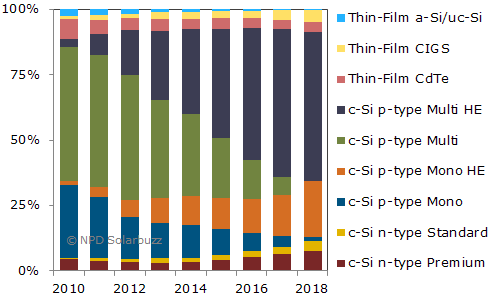Solar photovoltaic (PV) modules using solar-grade wafers, as offered by 16 of the top 20 solar module suppliers to the industry, will account for 89% of solar capacity forecast to be installed this year, according to the new NPD Solarbuzz PV Technology Roadmap report.
Thin-film panel manufacturers, led by First Solar and Solar Frontier, will supply nearly 8% of end-market demand in 2014, with premium crystalline silicon (c-Si) suppliers, such as SunPower and Panasonic, supplying the remaining 3% share.
Accelerated Technology Roadmap Scenario Forecast by PV Technology Type
“The solar photovoltaic industry will continue to offer strong growth potential for a wide range of PV manufacturing technologies,” said Finlay Colville, vice president at NPD Solarbuzz. “Panel power ratings are expected to constantly hit record levels of performance, provided efficiency enhancements are adequately prioritized.”
Over the next five years, solar PV manufacturing and end-market supply will be divided across three specific technology types: standard silicon-based manufacturing, using solar grade wafer substrates; premium c-Si based processes, using semiconductor grade material; and thin-film panels, using deposition techniques, analogous to those used within the flat-panel display industry.
“From the early growth phase of the solar PV industry through 2012, there were many differentiated and competing technologies under development,” Colville noted. “This made it particularly challenging to formulate a comprehensive roadmap that could be used to predict the industry’s technology growth.”
Under the NPD Solarbuzz “most-likely PV technology roadmap” scenario, thin-film and premium c-Si module supply is expected to increase from 5.3 GW in 2014 to 14.5 GW in 2018. New entrants to the premium c-Si category include SolarCity’s proposed capacity expansion of Silevo, and First Solar’s plans to move TetraSun’s PV technology into mass production.
“Market-share comparisons are benchmarks of the relative success of the various technologies, but the PV industry continues to experience high growth rates, with annual demand doubling almost every four years,” added Colville. “Technologies do not need to gain market share in order to grow shipment volumes or offer significant opportunities for equipment and materials suppliers.”
Competition between c-Si technologies, based on ingots manufactured by high-grade Czochralski (CZ) growth techniques and those produced by directional solidification furnaces customized for solar PV, will ultimately determine which technologies will prevail within the industry over the next five years.
In the NPD Solarbuzz “accelerated PV technology roadmap” scenario, greater market-share adoption is forecast for advanced c-Si cell concepts. The served addressable market for premium c-Si module suppliers is expected to grow 200% after 2015, reaching 7.6 GW in 2018.
“While cost reduction was the main focus of the PV manufacturing segment during the past two years, the industry is now ideally positioned to finally adopt a common technology roadmap,” Colville said. “As leading PV producers review capacity additions from 2015 onwards, being able to benchmark proposed technologies will become a critical part of factory tool design and targeted customer groupings.”


